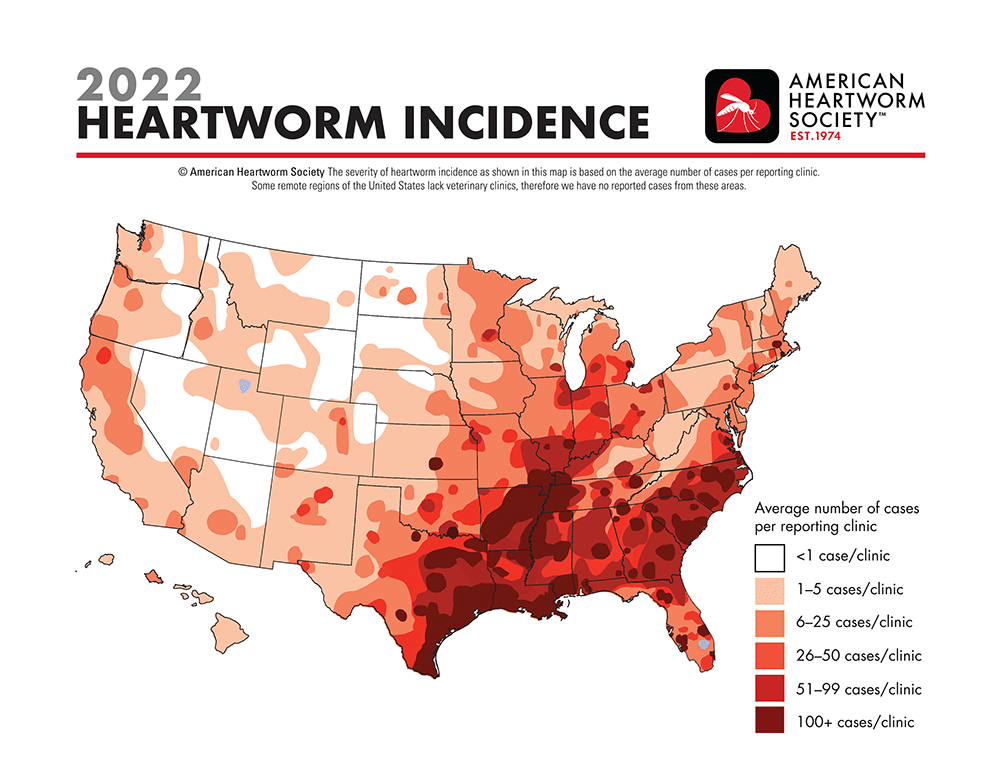Module 3: Healthcare practices for common medical conditions in shelters
Canine Heartworm Treatment Best Practices
Depending on geographical location, canine heartworm infection is a fairly common disease in shelter dogs. This is particularly true for shelters in the southern states where the infection is most prevalent. In heartworm-endemic regions, the prevalence of infection in shelter dogs may be more than 8 times the prevalence in locally owned pet dogs. Thus, sheltering agencies are much more likely to encounter infected dogs than are local veterinary clinics. However, heartworms and their mosquito vectors are found in all 50 states and incidence of infection continues to increase – no state is heartworm-free. As a result, the management of heartworm infection is a substantial and increasing concern for animal shelters across the country.

Review the 2024 AHS Canine Heartworm Guidelines Summary and the 2024 AHS Canine Heartworm Guidelines
Key Takeaways for AHS Canine Heartworm Treatment Recommendations
- No set protocol for pretreatment workup – reasonable judgment should be used to weigh the necessity, benefit, and extent of diagnostic procedures
- Large numbers of adulticide treatments have been successfully performed without pretreatment diagnostics such as CBC/chemistry panel and thoracic radiographs
- Exercise restriction during the entire treatment and recovery period is ESSENTIAL for minimizing pulmonary thromboembolic (PTE) complications from killing adult heartworms
- Monthly macrocyclic lactone heartworm preventive should be administered for 2 months prior to melarsomine treatment to eliminate microfilaria and larvae in tissues
- Macrocyclic lactones = ivermectin, milbemycin, selamection, moxidectin
- Moxidectin is the best choice for eliminating microfilariae without the adverse reactions seen with the other macrocyclic lactones. Topical moxidectin (Advantage Multi) is the only product labeled for use in microfilaremic dogs. Moxidectin also contributes to elimination of adult worms, whereas other macrocyclic lactones have poor efficacy.
- Doxycycline or minocycline (10 mg/kg BID) for 4 weeks prior to melarsomine eliminates Wolbachia bacteria that are essential for heartworm viability and reproduction.
- Weakens adult heartworms and increases susceptibility to adulticide treatment
- Suppresses microfilaria production and microfilariae cannot develop to adult worms
- Decreases inflammation and PTE due to dying heartworms after adulticide treatment
- 30-day wait period between finishing doxycycline treatment and before melarsomine treatment is recommended to allow time for clearance of dead Wolbachia and withering of adult worms (NOTE – this is a hypothesis without supporting evidence from clinical studies)
- The 2-dose melarsomine protocol kills about 90% of the adult worms.
- The 3-dose melarsomine protocol kills 99% of adult worms and has lower complication rates compared to the 2-dose protocol. This is the recommended protocol for melarsomine due to efficacy and safety.
- Prednisone administration with each melarsomine injection is recommended to help reduce risk for PTE from dying adult worms. The efficacy of melarsomine when used in conjunction with prednisone is not decreased.
- Administration of an analgesic such as tramadol, gabapentin, or hydrocodone at the time of injection reduces the acute myalgia associated with melarsomine injections.
- Dogs are not considered cured until there are 2 consecutive negative heartworm antigen tests 6 months apart.
- Monthly macrocyclic lactone heartworm preventive and doxycycline for 4 weeks may be considered when melarsomine treatment is not possible or contraindicated due to patient status.
- This “slow-kill” method takes up to 30 months for elimination of adult worms.
- This is strictly a salvage procedure and is not recommended for standard treatment because of the continued damage to the cardiovascular system during the long period of adult worm survival.
Here is a timeline for the AHS best practice canine heartworm treatment protocol. Note that the total time for restriction of activity from diagnosis to recovery post treatment is ≥5 months!
Remember that by the time a dog is diagnosed as heartworm-positive, heartworm disease has already begun in the heart and pulmonary artery. Damage from the infection can be permanent, so early elimination of heartworms with adulticidal therapy provides the best chance for a healthy life. The goal of heartworm treatment is to kill the greatest number of adult worms in the shortest possible time with the fewest potential complications.
Test Your Knowledge

